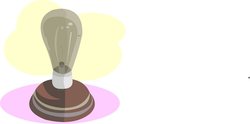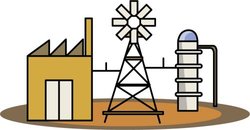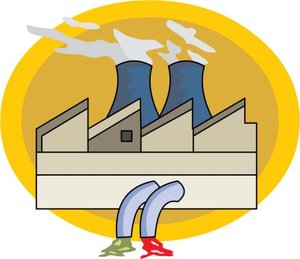Electricity
|
|
The SI unit of electricity is the coulomb, which has the abbreviation "C". The symbol Q is used in equations to represent the quantity of electricity or charge. For example, "Q = 0.5 C" means "the quantity of electric charge is 0.5 coulomb."
| Contents |
History
According to Thales of Miletus, writing circa 600 BCE, a form of electricity was known to the Ancient Greeks, who found that rubbing fur on various substances, such as amber, would cause a particular attraction between the two. The Greeks noted that the amber buttons could attract light objects such as hair, and that if they rubbed the amber for long enough, they could even get a spark to jump. This is the origin of the word "electricity", from the Greek ēlektron = "amber", which came from an old root ēlek- = "shine".
An object found in Iraq in 1938, dated to about 250 BCE and called the Baghdad Battery, resembles an electrochemical cell and is believed by some to have been used for electroplating. There is no firm documentary evidence to indicate what the object was used for, though. There are other descriptions of supposedly electrical devices on Egyptian walls, such as the Dendera light. Other devices discovered in Egyptian and other archaeological digs have been alleged to be electrical batteries.
In 1600 the English scientist William Gilbert returned to the subject in De Magnete, and coined the modern Latin word electricus from ηλεκτρον (elektron), the Greek word for "amber", which soon gave rise to the English words electric and electricity. He was followed in 1660 by Otto von Guericke, who is regarded as having invented an early electrostatic generator. Other European pioneers were Robert Boyle, who in 1675 stated that electric attraction and repulsion can act across a vacuum; Stephen Gray, who in 1729 classified materials as conductors and insulators; and C. F. Du Fay, who first identified the two types of electricity that would later be called positive and negative. The Leyden jar, a type of capacitor for electrical energy in large quantities, was invented at Leiden University by Pieter van Musschenbroek in 1745. William Watson, experimenting with the Leyden jar, discovered in 1747 that a discharge of static electricity was equivalent to an electric current.
In June, 1752, Benjamin Franklin promoted his investigations of electricity and theories through the famous, though extremely dangerous, experiment of flying a kite during a thunderstorm. Following these experiments he invented a lightning rod and established the link between lightning and electricity. If Franklin did fly a kite in a storm, he did not do it the way it is often described (as it would have been dramatic but fatal). It was either Franklin (more frequently) or Ebenezer Kinnersley of Philadelphia (less frequently) who created the convention of positive and negative electricity.
As a result of this discovery, the Chinese word for "lightning" is now also used to mean "eletricity".
Franklin's observations aided later scientists such as Michael Faraday, Luigi Galvani, Alessandro Volta, Andr魍arie Amp貥, and Georg Simon Ohm whose work provided the basis for modern electrical technology. The work of Faraday, Volta, Ampere, and Ohm is honored by society, in that fundamental units of electrical measurement are named after them.
Volta worked with chemicals and discovered that chemical reactions could be used to create positively charged anodes and negatively charged cathodes. When a conductor was attached between these, the difference in the electrical potential (also known as voltage) drives a current between them through the conductor. The potential difference between two points is measured in units of volts in recognition of Volta's work.
The late 19th and early 20th century produced such giants of electrical engineering as Nikola Tesla, inventor of the induction motor and the fundamental alternating current transmission system, Samuel Morse, inventor of the telegraph; Antonio Meucci, inventor of the telephone; Thomas Edison (inventor of the phonograph and a practical incandescent light bulb); George Westinghouse, inventor of the electric locomotive; Charles Steinmetz, theoretician of alternating current.
Nikola Tesla performed experiments with very high voltages that are the stuff of legend, involving ball lightning and other effects (some have been duplicated or explained; and others which have not). Nikola Tesla, inventor of the induction motor and developer of polyphase systems, contributed to the world of electrodynamics the theory of polyphase alternating current, which he used to build the first induction motor, invented in 1882. In May 1885, Westinghouse, then president of the Westinghouse Electric Company in Pittsburgh, Pennsylvania, bought the rights to Tesla's patents for polyphase alternating-current dynamos. This led to a contest in the so-called court of public opinion as to which system would be adopted as the standard for power transmission (known as the War of Currents), Edison's direct-current system or Westinghouse's alternating-current method.
Edison conducted a spirited public relations campaign which included his promotion of the electric chair as a method of execution. The electric chair ran on Westinghouse's AC; Edison wanted to prove that AC power was capable of killing, and should therefore be viewed by the public as inherently dangerous. This fear, uncertainty and doubt campaign included the electrocution of Topsy the Elephant. AC power was eventually adopted as the standard.
Electric power
Electric power is the popular name given to electrical energy production and distribution. For most consumers, electrical energy is generated centrally by utility companies using coal, natural gas, hydropower, nuclear power or petroleum. In 2000, U.S. electric utilities had 600 gigawatts of maximum summer generating capacity including 261 GW from coal, 118 GW from natural gas, 92 GW from hydropower, 86 GW from nuclear and 41 GW from petroleum. Little generating capacity is presently based on renewable energy sources such as solar power and wind power. Some individuals and communities prefer renewable sources because there is less pollution and because users of renewable energy sources can sometimes gain a measure of economic independence from the electrical utilities.
Devices powered by electrical energy include lamps, computers and the Internet, radio and television, refrigeration, air conditioning, traffic signals, electric guitars and other electronic musical instruments, and the spark plugs in automobiles. A summary of the applications of electric energy (written for non-specialists, and briefly explaining motors, transformers, transistors, digital, etc.) is the book, Industrial Electronics for Engineers, Chemists, and Technicians, by D. J. Shanefield, William Andrew Publishing (Norwich, NY), 2001.
In electrical engineering, the energy in electromagnetic fields is harnessed to perform useful work—either as a method to transmit energy to the appropriate place and then convert it back into a different, useful form of energy (for instance, heat, light, or motion), or by using the presence or level of electricity to convey information.
Today's electrical engineers enjoy the ability to design circuits using pre-manufactured building blocks such as power supplies, resistors, capacitors, semiconductors such as transistors, and integrated circuits. An integrated circuit inside a computer, the microprocessor, performs millions of computations per second.
Electric current
A flow of electricity is called an electric current. A direct current (DC) is a unidirectional flow; alternating current (AC) is a flow whose time average is zero, but is not zero at all times. That definition of AC implies that the flowing electricity repeatedly changes direction. (Polarity and numerical sign (i.e. negative vs. positive) are additional terms for direction in this sense).
It is often important, particularly for safety reasons, that one side of a circuit be electrically bonded to an earth terminal. Such an earth terminal is usually connected to an electrode buried in the ground. The potential of earth (ground) is defined as zero by convention, and the electrical conductivity between similarly buried electrodes is considered to be low enough that all earth terminals are effectively at the same voltage.
The electricity which occurs naturally within conductors can be forced to flow, while the charges within insulators are locked in place and cannot be moved. Some electrical devices that use electrical physics are called electronic devices. See electrical conduction for more information about charge flow in materials.
Ohm's Law is an important relationship describing the behaviour of electric currents. For historical reasons, electricity is said to flow from the most positive part of a circuit to the most negative part. The electric current thus defined is called conventional current. It is now known that, depending on the type of conductor, an electric current can consist of a flow of charged particles in either direction, or even in both directions at once. The positive-to-negative convention is widely used to simplify this situation. If another definition is used - for example, "electron current" - it should be explicitly stated.
Terminology issues
In addition to its definition by physicists, the word electricity has several popular definitions which are contradictory. Rather than using the word electricity to refer to the quantity of electric charge, many sources instead say that electricity is the quantity of electromagnetic energy measured in joules or kilowatt-hours. Other sources call the motion of charges within a conductor by the name electricity, and they measure the quantity of electricity in terms of amperes. Still others call a wide variety of electrical phenomena by the name electricity, e.g. bioelectricity, piezoelectricity, triboelectricity, etc. It is advisable to be extremely careful when interpreting texts which employ the frequently misused term "electricity" in place of the more accurate terms electric charge, electric current, electrical energy, etc.
SI electricity units
Template:SI electromagnetism units
See also
- Main: electromagnetic, phenomenon (electric charge), electric power (for energy transfer using electricity), electric shock, electric chair (execution)
- Things: Battery, Lightning, Conductor
- Engineering: Green electricity, Electrical wiring
Electrical phenomena in nature
- Lightning
- Bioelectricity — Many animals are sensitive to electric fields, some (e.g., sharks) more than others (e.g., people). Most also generate their own electric fields, and a few, like the electric eel, deliberately generate strong fields to detect or stun their prey.
- Neurons in the nervous system transmit information by electrical impulses known as action potentials.
- Matter — since atoms and molecules are held together by electric forces.
- The Earth's magnetic field — created by electric currents circulating in the planet's core.
- Sometimes due to solar flares, a phenomenon known as a power surge can be created, which can be very damaging to sensitive electrical equipment such as computers. However, such damage can be prevented by using a surge protector.



